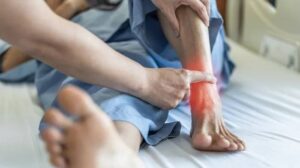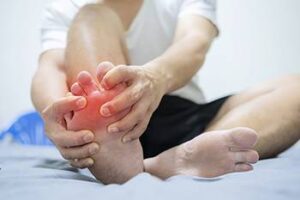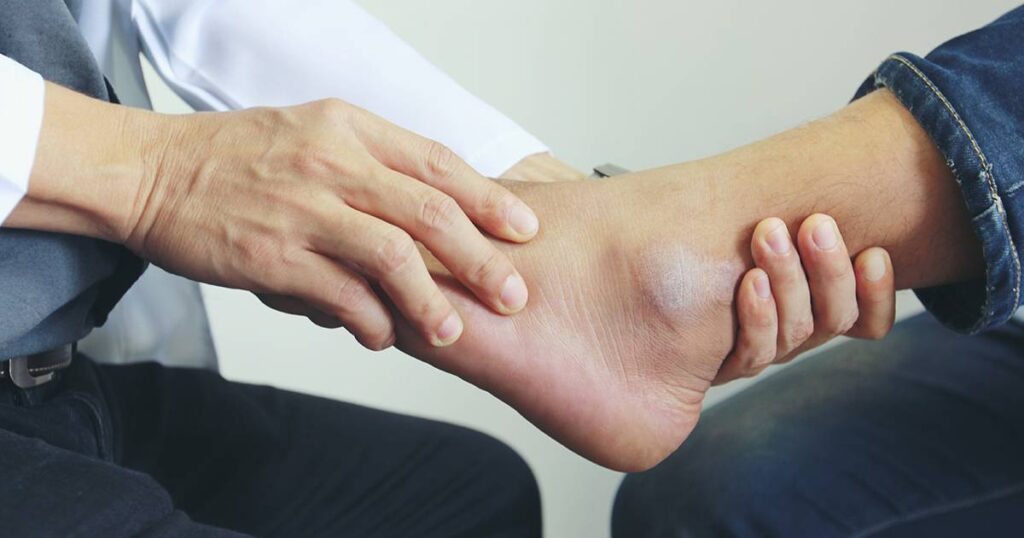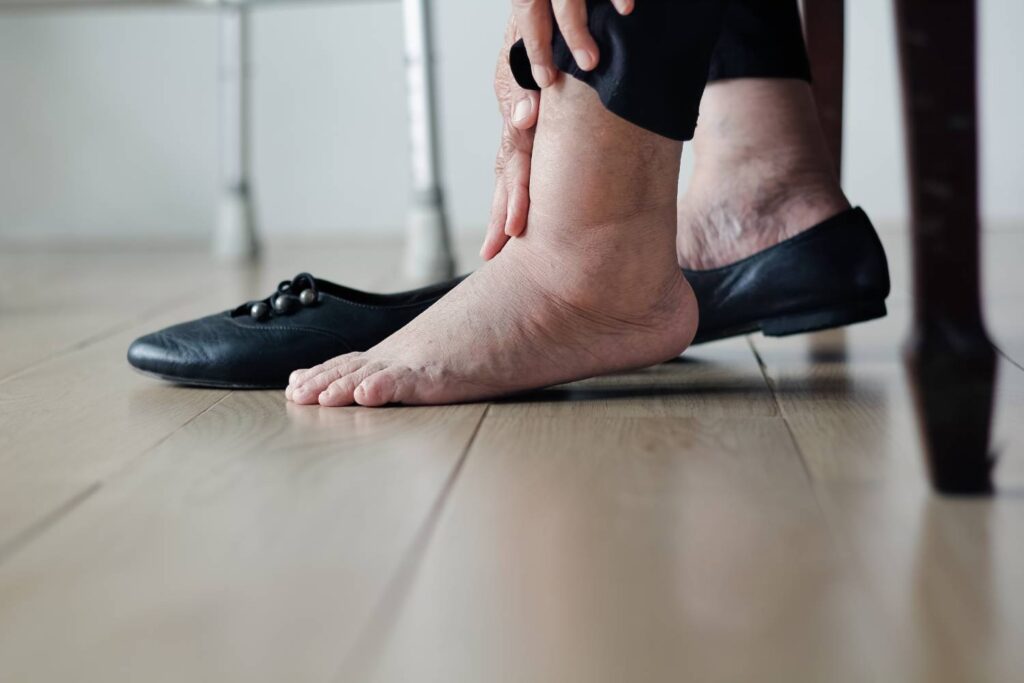Have you ever felt pain or stiffness in your feet, making it hard to walk or stand for long periods? It could be a sign of arthritis, a condition that affects the joints and is more common than you might think, especially in the feet.
Arthritis in the feet can sneak up on you, often starting as mild discomfort that gradually worsens. It can make even the simplest tasks like walking, climbing stairs, or standing painful and exhausting. But the good news is, understanding the early signs and getting the right treatment can make a huge difference in managing the pain and keeping you on your feet.
In this blog, we’ll talk about how arthritis affects the foot, the early symptoms to watch out for, and the best treatments to keep your feet healthy and pain-free. So, if you’ve been struggling with foot pain or just want to know how to prevent it, keep reading!
Contents
Common Types of Arthritis That Affect the Foot
 Arthritis in the foot can be caused by several different conditions, each with its own impact on your joints. The most common types of arthritis that affect the foot include osteoarthritis, rheumatoid arthritis, and psoriatic arthritis. Here’s how each one can affect your feet:
Arthritis in the foot can be caused by several different conditions, each with its own impact on your joints. The most common types of arthritis that affect the foot include osteoarthritis, rheumatoid arthritis, and psoriatic arthritis. Here’s how each one can affect your feet:
-
Osteoarthritis (OA)
-
OA is the most common form of arthritis and is often referred to as “wear and tear” arthritis. It occurs when the cartilage in the joints breaks down over time, leading to pain, stiffness, and swelling. In the foot, OA most often affects the big toe, the ankle, and the midfoot, making movement painful.
-
-
Rheumatoid Arthritis (RA)
-
RA is an autoimmune condition where the body’s immune system attacks its own joints. This type of arthritis can cause inflammation in the foot joints, particularly in the toes, arches, and ankles. RA can lead to deformities and severe joint damage if left untreated, making it harder to walk or stand for extended periods.
-
-
Psoriatic Arthritis (PsA)
-
PsA is a type of arthritis associated with psoriasis, a skin condition. It can cause pain, swelling, and joint stiffness in the feet, particularly in the toes and heels. PsA can lead to inflammation in the small joints of the feet, resulting in changes in the shape and appearance of the toes (like “sausage” toes).
-
Each type of arthritis has different causes and treatment approaches, but they all share one thing in common: they affect the mobility of your feet and can make daily activities painful.
How Arthritis Affects the Joints in the Foot
 Arthritis in the foot can affect several joints, leading to pain, swelling, and stiffness. Here’s how arthritis impacts the joints and affects your ability to move:
Arthritis in the foot can affect several joints, leading to pain, swelling, and stiffness. Here’s how arthritis impacts the joints and affects your ability to move:
-
Inflammation of Joints
Arthritis causes inflammation in the joints, especially in the toes, midfoot, and ankles. This swelling makes movement painful and can limit the range of motion in these joints. -
Damage to Cartilage
In conditions like osteoarthritis, the cartilage between joints breaks down, leading to bone-on-bone contact. This can cause pain, stiffness, and a grinding sensation when moving the foot. -
Changes in Joint Shape
Chronic inflammation can lead to joint deformities, such as bunions or hammer toes, which can make it difficult to wear shoes or walk comfortably. -
Loss of Flexibility
The joints affected by arthritis may become less flexible over time, making it harder to bend the toes or foot. This loss of flexibility can affect your ability to walk and perform everyday tasks. -
Increased Risk of Fall or Injury
The combination of joint pain, stiffness, and swelling can affect balance and mobility, increasing the risk of falls or injuries when walking or standing for long periods.
Understanding how arthritis affects the joints in the foot is crucial for managing symptoms and preventing further joint damage. Early treatment and lifestyle changes can help protect your foot joints and improve overall mobility.
Early Symptoms of Arthritis in the Feet
 If you’re experiencing arthritis in the feet, the symptoms often develop gradually. Here are some of the early signs to watch out for:
If you’re experiencing arthritis in the feet, the symptoms often develop gradually. Here are some of the early signs to watch out for:
- Pain in the Joints (especially in the big toe, ankles, or midfoot)
- Swelling (you may notice that your shoes feel tighter than usual or that your feet look puffy)
- Stiffness (it may be hard to move your toes or flex your foot at first)
- Tenderness to Touch (feet may become tender or painful to the touch)
- Reduced Range of Motion (you have less flexibility in your feet, making it harder to bend or stretch your toes)
- Warmth in the Joints (affected joints feel warmer than usual, which is a sign of increased blood flow to the area)
- Changes in Joint Shape or Appearance
If you’re experiencing any of these symptoms, it’s important to talk to a doctor for an early diagnosis and start an appropriate treatment plan to prevent further damage.
Treatment Options for Foot Arthritis

Managing foot arthritis involves a combination of medications, physical therapy, and lifestyle changes to reduce pain, improve mobility, and prevent further joint damage. Here are some of the most effective treatment options:
Medications
- NSAIDs (Nonsteroidal Anti-Inflammatory Drugs): Over-the-counter pain relievers like ibuprofen can help reduce pain and inflammation.
- Corticosteroid Injections: These can provide temporary relief by reducing inflammation directly in the affected joint.
- Disease-modifying Antirheumatic Drugs (DMARDs): For autoimmune types like rheumatoid arthritis, DMARDs can help slow the disease’s progression and manage symptoms.
- Biologics: Used for severe cases of inflammatory arthritis, biologics help target specific parts of the immune system to reduce inflammation.
Physical Therapy
- Stretching and Strengthening Exercises: A physical therapist can teach you exercises that help increase joint flexibility, improve strength, and reduce stiffness in the foot.
- Orthotics: Custom shoe inserts or braces can help support the foot, correct alignment, and reduce pain while walking.
Lifestyle Changes
- Weight Management: Reducing excess weight can reduce stress on the joints, especially weight-bearing joints like the feet.
- Low-impact Exercises: Activities like swimming, cycling, and walking can help maintain mobility without putting too much strain on the foot joints.
- Foot Care: Wearing well-fitting shoes, using foot pads, and keeping your feet clean and moisturized can prevent additional discomfort or damage to the skin and joints.
Surgical Interventions (In Severe Cases)
- Arthroplasty: Joint replacement surgery may be an option for patients with advanced arthritis who do not find relief through conservative treatments.
- Fusion Surgery: In cases of severe damage, joint fusion can help reduce pain by eliminating movement in the affected joint.
By combining these treatment options, you can effectively manage foot arthritis, reduce pain, and improve your quality of life. It’s important to consult with a doctor or specialist to develop a treatment plan that’s tailored to your needs.
Home Remedies to Alleviate Foot Arthritis Pain
 Managing foot arthritis at home can be an effective way to relieve pain, reduce inflammation, and improve mobility. Here are some simple yet effective home remedies to help alleviate foot arthritis pain:
Managing foot arthritis at home can be an effective way to relieve pain, reduce inflammation, and improve mobility. Here are some simple yet effective home remedies to help alleviate foot arthritis pain:
- Apply an ice pack wrapped in a cloth to the affected foot for 15-20 minutes. Do this several times a day, especially after physical activity.
- Elevate your foot on a pillow while resting. This can help reduce swelling and improve circulation, which may alleviate some of the pain associated with arthritis.
- Soak your feet in warm water mixed with Epsom salts for about 15-20 minutes. The warmth helps relax the muscles, and Epsom salts can reduce swelling and inflammation.
- Perform gentle stretches and strengthening exercises for your feet, such as rolling a tennis ball under your foot or doing toe stretches.
- Gently massage the affected areas of your foot with a soothing cream or oil. This can improve blood circulation, reduce tension, and provide temporary pain relief.
- Use padded insoles or foot cushions in your shoes to help reduce pressure on your joints and make walking more comfortable.
- Natural remedies like turmeric or ginger tea have anti-inflammatory properties. Drinking them regularly or applying turmeric paste to the affected area can help reduce swelling.
- Choose shoes that provide good arch support and cushioning to reduce strain on the joints. Avoid high heels or shoes with poor support that can worsen pain.
These home remedies are a great way to manage arthritis symptoms and make your feet feel better throughout the day. However, if pain persists or worsens, it’s important to consult a doctor for professional treatment.
When to Consult a Specialist?
If you’re experiencing persistent foot pain, swelling, or stiffness that doesn’t improve with home remedies, it’s time to seek help from a specialist. Early intervention can prevent further joint damage and improve your mobility.
You should consult an orthopedician or rheumatologist if:
- Foot pain is constant or gets worse over time
- Swelling and discomfort interfere with daily activities
- You notice changes in the shape of your feet or toes (such as lumps, bunions, or crooked toes)
- Over-the-counter pain relievers or home remedies aren’t providing relief
- You experience difficulty walking or standing for extended periods
If you’re dealing with arthritis in your feet and need professional advice or treatment, MantraDoc is here to help. You can easily connect with an online orthopedician who specializes in foot arthritis and can guide you through the right treatments.
👉 Click here to consult with an online orthopedician today!

